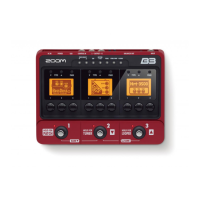
Do you have a question about the Zoom B3 and is the answer not in the manual?
| Simultaneous Effects | 3 |
|---|---|
| Display | LCD |
| Tuner | Yes |
| Power | 9V DC adapter |
| USB | Yes |
| Weight | 1.2 kg |
| MIDI I/O | No |
| Power Consumption | 500 mA |
| Sampling Frequency | 44.1 kHz |
| A/D Conversion | 24-bit, 128x oversampling |
| D/A Conversion | 24-bit, 128x oversampling |
| Amp Models | Yes |
| Looper | 40 seconds |
| Drum Machine | Yes |
| Inputs | 1 x 1/4" instrument |
| Power Source | 9V DC adapter |
| Presets | 100 |
| Patches | 100 user patches |
Essential warnings and precautions for safe operation, including battery and adapter handling.
Guidelines on operating environment, interference, cleaning, and malfunction.
Highlights the device's capabilities like amp modeling, effect combinations, and looper synchronization.
Explains core terminology such as 'Patch' for effect settings and 'Bank' for patch organization.
Identifies and describes the controls and displays located on the top surface of the unit.
Details the various input and output jacks found on the rear of the unit.
Step-by-step instructions for powering on the device using batteries or an AC adapter.
Explains the function and appearance of the unit's Home and Edit screen modes.
Procedure for enabling or disabling individual effects using footswitches.
How to choose and change the active effect algorithm.
Details on how to fine-tune the settings of selected effects using parameter knobs.
Instructions on how to move between different parameter pages for editing.
How to enter the mode for selecting saved sounds (patches).
Steps to select different saved sounds using the unit's controls.
Procedure for navigating through groups of patches organized into banks.
Exiting patch selection mode and returning to the primary display.
Guide on how to save new patches or replace existing ones.
Choosing the specific bank and number for saving a patch.
Finalizing the process of storing or swapping a patch.
How to enter the TOTAL menu for patch-specific global settings.
Setting the overall volume and mix balance for a patch.
Instructions for changing the sequence of effects within a patch.
Procedure for renaming saved patches for easier identification.
Assigning parameters and ranges for control via an expression pedal.
Customizing the actions assigned to the unit's footswitches.
Steps to exit the TOTAL menu and return to normal operation.
How to enter the GLOBAL menu for system-wide adjustments.
Setting global volume and tempo that affect all patches.
Using the TAP button to set the tempo for rhythms and looper.
Configuring signal routing direction and backlight dimming time.
Selecting battery type and adjusting USB audio monitoring/recording levels.
Checking firmware versions and adjusting the display contrast.
How to engage the tuner and its basic operation.
Adjusting standard pitch and selecting tuner types (Chromatic, Bass).
Using drop tuning and tuning the bass guitar accurately.
Procedure for stopping the tuner and returning to normal playback.
How to engage and choose from the built-in rhythm patterns.
Setting the speed for rhythm patterns using knobs or tapping.
Adjusting rhythm volume and stopping pattern playback.
Exiting rhythm mode and returning to previous screens.
Engaging the looper and setting recording time and tempo.
Adjusting the tempo for recorded loops.
Capturing audio phrases and playing them back in a loop.
Setting the output level for the recorded loop.
Adding multiple layers to a loop and clearing recordings.
Halting the playback of the current loop.
Exiting looper mode and returning to the main operation screens.
Configuring Undo function, stop mode, and rhythm level.
Connecting the unit to a computer for firmware update preparation.
Steps to perform the firmware update using the computer application.
Finalizing the firmware update process after completion.
Restoring the unit to its original factory default settings.
Lists the operating systems supported for computer connectivity.
Details on quantization bit-rate and sampling frequency.
Introduces the comprehensive list of effects, parameters, and their functions.
Troubleshooting steps for power and audio output problems.
Resolving issues with sound timbre, effect bypass, and pedal response.
Details on effect types, simultaneous effects, I/O, power, and dimensions.
A list of preset patches created by artists, with comments on their sound.
Instructions for installing the Sequel LE software on Windows operating systems.
Instructions for installing the Sequel LE software on macOS.
Guide on how to record audio tracks using the Sequel LE software.
Tips for ensuring smooth operation of Sequel LE with the unit.
